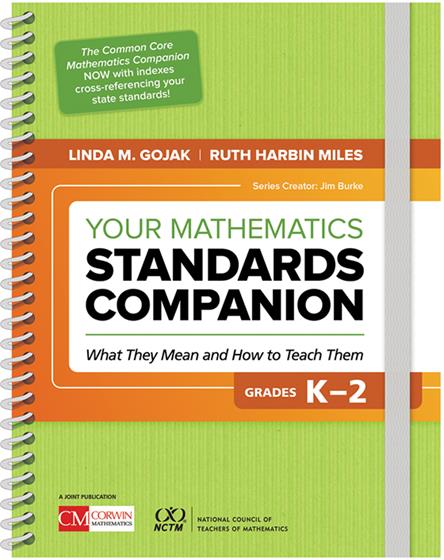Indexes Cross-Referencing Your State Standards
Quick Reference Guide
Acknowledgments
Letter to Grades K–2 Teachers
Letter to Elementary School Principals
Introduction
A Brief History of Current State Standards
College and Career Ready Standards for Mathematics
Instructional Shifts
Terminology Used in This Book
Effective Teaching Practices
How to Use This Book
Reflection Questions
Part 1. Counting and Cardinality
Domain Overview
Suggested Materials for This Domain
Key Vocabulary
Kindergarten
Cluster A: Know number names and the count sequence.
Cluster B: Count to tell the number of objects.
Cluster C: Compare numbers.
Sample Planning Page: Counting and Cardinality, Kindergarten, Cluster B
Planning Pages
Reflection Questions: Counting and Cardinality
Part 2. Operations and Algebraic Thinking
Domain Overview
Suggested Materials for This Domain
Key Vocabulary
Kindergarten
Cluster A: Understand addition as putting together and adding to, and understand subtraction as taking apart and taking from.
Sample Planning Page: Operations and Algebraic Thinking, Kindergarten, Cluster A
Planning Page
Grade 1
Cluster A: Represent and solve problems involving addition and subtraction.
Cluster B: Understand and apply properties of operations and the relationship between addition and subtraction.
Cluster C: Add and subtract within 20.
Cluster D: Work with addition and subtraction equations.
Sample Planning Page: Operations and Algebraic Thinking, Grade 1, Cluster C
Planning Pages
Grade 2
Cluster A: Represent and solve problems involving addition and subtraction.
Cluster B: Add and subtract within 20.
Cluster C: Work with equal groups of objects to gain foundations for multiplication.
Sample Planning Page: Operations and Algebraic Thinking, Grade 2, Cluster A
Planning Pages
Reflection Questions: Operations and Algebraic Thinking
Part 3. Number and Operations in Base Ten
Domain Overview
Suggested Materials for This Domain
Key Vocabulary
Kindergarten
Cluster A: Work with numbers 11–19 to gain foundation for place value.
Sample Planning Page: Number and Operations in Base Ten, Kindergarten, Cluster A
Planning Page
Grade 1
Cluster A: Extend the counting sequence.
Cluster B: Understand place value.
Cluster C: Use place value understanding and properties of operations to add and subtract.
Sample Planning Page: Number and Operations in Base Ten, Grade 1, Cluster C
Planning Pages
Grade 2
Cluster A: Understand place value.
Cluster B: Use place value understanding and properties of operations to add and subtract.
Sample Planning Page: Number and Operations in Base Ten, Grade 2, Cluster B
Planning Pages
Reflection Questions: Number and Operations in Base Ten
Part 4. Measurement and Data
Domain Overview
Suggested Materials for This Domain
Key Vocabulary
Kindergarten
Cluster A: Describe and compare measurable attributes.
Cluster B: Classify objects and count the number of objects in each category.
Sample Planning Page: Measurement and Data, Kindergarten, Cluster A
Planning Pages
Grade 1
Cluster A: Measure lengths indirectly and by iterating length units.
Cluster B: Tell and write time.
Cluster C: Represent and interpret data.
Sample Planning Page: Measurement and Data, Grade 1, Cluster C
Planning Pages
Grade 2
Cluster A: Measure and estimate lengths in standard units.
Cluster B: Relate addition and subtraction to length.
Cluster C: Work with time and money.
Cluster D: Represent and interpret data.
Sample Planning Page: Measurement and Data, Grade 2, Cluster D
Planning Pages
Reflection Questions: Measurement and Data
Part 5. Geometry
Domain Overview
Suggested Materials for This Domain
Key Vocabulary
Kindergarten
Cluster A: Identify and describe shapes.
Cluster B: Analyze, compare, create, and compose shapes.
Sample Planning Page: Geometry, Kindergarten, Cluster A
Planning Pages
Grade 1
Cluster A: Reason with shapes and their attributes.
Sample Planning Page: Geometry, Grade 1, Cluster A
Planning Page
Grade 2
Cluster A: Reason with shapes and their attributes.
Sample Planning Page: Geometry, Grade 2, Cluster A
Planning Page
Reflection Questions: Geometry
Resources
Table 1. Addition and Subtraction Situations
Table 2. Addition and Subtraction Fact Strategies
Table 3. Scaffolding Addition and Subtraction
Table 4. Sample Addition and Subtraction Strategies
Table 5. Standards for Mathematical Practice
Table 6. Effective Teaching Practices
Reproducibles
Reproducible 1. Five Frame
Reproducible 2. Ten Frame
Reproducible 3. Double Ten Frame
Reproducible 4. Hundreds Chart
Reproducible 5. Dot Cards
Reproducible 6. Numeral Cards
Reproducible 7. Number Line to 20
Reproducible 8. Open Number Line
Reproducible 9. Part-Part-Whole Chart
Reproducible 10. Place Value Chart (Tens/Ones)
Reproducible 11. Place Value Chart (Hundreds/Tens/Ones)
Reproducible 12. Comparison Cards
Additional Resources
About the Authors




